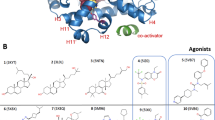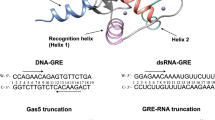Abstract
The ability of nuclear receptors (NRs) to activate transcription of target genes requires the binding of cognate ligands to their ligand-binding domains (LBDs). Information provided by the three-dimensional structures of the unliganded RXRα and the liganded RARγ LBDs has been incorporated into a general alignment of the LBDs of all NRs. A twenty amino-acid region constitutes a NR-specif ic signature and contains most of the conserved residues that stabilize the core of the canonical fold of NR LBDs. A common ligand-binding pocket, involving predominantly hydrophobic residues, is inferred by homology modelling of the human RXRα and glucocorticoid receptor ligand-binding sites according to the RARγ holo-LBD structure. Mutant studies support these models, as well as a general mechanism for ligand-induced activation deduced from the comparison of the transcriptionally active RARγ holo- and inactive RXRα apo-LBD structures.
This is a preview of subscription content, access via your institution
Access options
Subscribe to this journal
Receive 12 print issues and online access
$189.00 per year
only $15.75 per issue
Buy this article
- Purchase on Springer Link
- Instant access to full article PDF
Prices may be subject to local taxes which are calculated during checkout
Similar content being viewed by others
References
Gronemeyer, H. & Laudet, V., Nuclear Receptors. Protein Profile 2, (Academic Press, 1995), in the press.
Green, S. & Chambon, P. Nuclear receptors enhance our understanding of transcription regulation. Trends Genet 4, 309–314 (1988).
Evans, R.M. The steroid and thyroid hormone receptor superfamily. Science 240, 889–895 (1988).
Gronemeyer, H. Transcription activation by estrogen and progesterone receptors. A. Rev. Genet. 25, 89–123 (1991).
Leid, M., Kastner, P. & Chambon, P. Multiplicity generates diversity in the retinoic acid signalling pathways. Trends Biochem. Sci. 17, 427–433 (1992).
Chambon, P. The retinoid signalling pathway: molecular and genetic analysis. Semin. Cell Biol. 5, 115–125 (1994).
Saatcioglu, F., Claret, F.X. & Karin, M. Negative transcriptional regulation by nuclear receptors. Sem. Cancer Biol. 5, 347–359 (1994).
Dey, A., Minucci, S. & Ozato, K. Ligand-dependent occupancy of the retinoic acid receptor beta 2 promoter in vivo. Mol. cell. Biol. 14, 8191–8201 (1994).
Truss, M., Bartsch, J. & Beato, M. Antiprogestins prevent progesterone receptor binding to hormone responsive elements in vivo. Proc. natn. Acad. Sci. U.S.A. 91, 11333–11337 (1994).
Zenke, M., Munoz, A., Sap, J., Vennström, B. & Beug, H. V-erba oncogene activation entails the loss of hormone-dependent regulator activity of c-erbA. Cell 61, 1035–1049 (1990).
Danielian, P.S., White, R., Lees, J.A. & Parker, M.G. Identification of a conserved region required for hormone dependent transcriptional activation by steroid hormone receptors. EMBO J. 11, 1025–1033 (1992).
Barretino, D., Vivanco-Ruiz, M.d.M. & Stunnenberg, H.G. Characterization of the ligand-dependent transactivation domain of thyroid hormone receptor. EMBO J. 13, 3039–3049 (1994).
Durand, B. et al. Activation function 2 (AF-2) of RAR and RXR: presence of a conserved autonomous constitutive activating domain and influence of the nature of the response element on AF-2 activity. EMBO J. 13, 5370–5382 (1994).
Leng, X. et al. Mouse retinoid X receptor contains a separable ligand-binding and transactivation domain in its E region. Mol. cell. Biol. 15, 255–263 (1995).
Halachmi, S. et al. Oestrogen receptor-associated proteins: possible mediators of hormone-induced transcription. Science 264, 1455–1458 (1994).
Cavaillès, V., Dauvois, S., Danielian, P.S. & Parker, M.G. Interaction of proteins with transcriptionally active estrogen receptors. Proc. natn. Acad. Sci. U.S.A. 91, 10009–10013 (1994).
Cavaillès, V. et al. Nuclear factor RIP140 modulates transcriptional activation by the estrogen receptor. EMBO J. 14, 3741–3751 (1995).
LeDouarin, B. et al. The N-terminal part of TIF1, a putative mediator of the ligand-dependent activation function (AF-2) of nuclear receptors, is fused to B-raf in the oncogenic protein T18. EMBO J. 14, 2020–2033 (1995).
Lee, J.W., Ryan, F., Swaffield, J.C., Johnston, S.A. & Moore, D.A. Interaction of thyroid-hormone receptor with a conserved transcriptional mediator. Nature 374, 91–94 (1995).
Vom Baur, E. et al. Differential ligand-dependent interactions between the AF-2 activating domain of nuclear receptors and the putative transcriptional intermediary factors mSUG1 and TIF1. EMBO J. in the press.
Hörlein, A.J. et al. Ligand-independent repression by the thyroid hormone receptor mediated by a nuclear receptor co-repressor. Nature 377, 397–403 (1995).
Kurokawa, R. et al. Polarity-specific activities of retinoic acid receptors determined by a co-repressor. Nature 377, 451–454 (1995).
Chen, J.D. & Evans, R.M. A transcriptional co-repressor that interacts with nuclear hormone receptors. Nature 377, 454–457 (1995).
Gronemeyer, H. & Moras, D. How to finger DNA. Nature 375, 190–191 (1995).
Bourguet, W., Ruff, M., Chambon, P., Gronemeyer, H. & Moras, D. Crystal structure of the ligand-binding domain of the human nuclear receptor RXRa. Nature 375, 377–382 (1995).
Renaud, J.P. et al. D Crystal structure of the RARg ligand-binding domain bound to all-trans retinoic acid. Nature in the press.
Laudet, V., Hanni, C., Coll, J., Catzeflis, F. & Stehelin, D. Evolution of the nuclear receptor gene superfamily. EMBO J. 11, 1003–1013 (1992).
Koelle, M.R. et al. The Drosophila EcR gene encodes an ecdysone receptor, a new member of the steroid receptor superfamily. Cell 67, 59–77 (1991).
Program Manual for the Wisconsin Package, Version 8, September 1994, Genetics Computer Group, 575 Science Drive, Madison, Wisconsin, USA 53711.
Lee, S. et al. A somatic cell genetic method for identification of untargeted mutations in the glucocorticoid receptor that cause hormone binding deficiencies. Molec. Endocrinol. 9, 826–837 (1995).
Benhamou, B. et al. A single amino acid that determines the sensitivity of progesterone receptors to RU486. Science 255, 206–209 (1992).
Sultan, C., Lumbroso, S., Poujol, N., Belon, C., Boudon, C. & Lobaccaro, J.M. Mutation of androgen receptor gene in androgen insensitivity syndromes. J. Steroid Biochem. molec. Biol. 46, 519–530 (1993).
Carlstedt Duke, J. et al. Identification of hormone-interacting amino acid residues within the steroid-binding domain of the glucocorticoid receptor in relation to other steroid hormone receptors. J. biol. Chem. 263, 6842–6848 (1988).
Strömstedt, P.E., Berkenstam, A., Jörnvall, H., Gustafsson, J.A. & Carlstedt-Duke, J. Radiosequence analysis of the human progestin receptor charged with [3H]promegestone. J. biol. Chem. 265, 12973–12977 (1990).
Yarbrough, W.G. et al. A single base insertion in the androgen receptor gene causes androgen insensitivity in the testicular feminized rat. J. biol. Chem. 265, 8893–8900 (1990).
Weiss, R.E. & Refetoff, S. Thyroid hormone resistance. A. Rev. Med. 43, 363–375 (1992).
Byravan, S. et al. Two point mutations in the hormone binding domain of the mouse glucocorticoid receptor that dramatically reduce its function. Molec. Endocrinol. 5, 752–758 (1991).
Veldscholte, J. et al. A mutation in the ligand binding domain of the androgen receptor of human LNCaP cells affects steroid binding characteristics and response to anti-androgens. Biochem. Biophys. Res. Commun. 173, 534–540 (1990).
Bhat, M.K., McPhie, P., Ting, Y.T., Zhu, X-G. & Cheng, S-Y. Structure of the carboxy-terminal region of thyroid hormone nuclear receptors and its possible role in hormone-dependent intermolecular interactions. Biochemistry 34, 10591–10599 (1995).
Ashraf, J. & Thompson, E.B. Identification of the activation-labile gene: a single point mutation in the human glucocorticoid receptor presents as two major phenotypes. Molec. Endocrinol. 7, 631–642 (1993).
Leid, M. Ligand-induced alteration of the protease sensitivity of retinoid X receptor alpha. biol. Chem. 269, 14175–14181 (1994).
Thompson, J.D., Higgins, D.G. & Gibson, T.J. ClustalW: improving the sensitivity of progessive multiple sequence alignment through sequence weighting, position-specific gap penalties and weight matrix choice. Nucleic Acids Res. 22, 4673–4680 (1994).
Henikoff, S. & Henikoff, J.G. Amino acid substitution matrices from protein blocks. Proc. natn. Acad. Sci.U.S.A. 89, 10915–10919 (1992).
Pierrat, B., Heery, D.M., Chambon, P. & Losson, R. A highly conserved region in the hormone-binding domain of the human estrogen receptor functions as an efficient transactivation domain in yeast. Gene 143, 193–200 (1994).
Milhon, J., Kohli, K. & Stallcup, M.R. Genetic analysis of the N-terminal end of the glucocorticoid receptor hormone binding domain. J. Steroid Biochem. molec. Biol. 51, 11–19, (1994).
Vriend, G. A molecular modelling and drug design program. J. molec. Graph. 8, 52–56 (1990).
Rohrer, D.C. & Duax, W.L. 9a-Fluoro-16a-Methyl-11b,17a,21-Trihydroxy-1,4-pregnadiene-3,20-dione[Dexamethasone](C22H29FO5). Cryst. struct. Commun. 6, 123–126 (1977).
Zechel, C., Shen, X.Q., Chambon, P. & Gronemeyer, H. Dimerization interfaces formed between the DNA binding domains determine the cooperative binding of RXR/RAR and RXR/TR heterodimersto DR5 and DR4 elements. EMBO J. 13, 1414–1424 (1994).
Bourguet, W. et al. Purification, functional characterization, and crystallization of ligand-binding domain of the retinoid X receptor. Protein Expr. Pur. 6, 604–608 (1995)
Kraulis, P.J. MOLSCRIPT: a program to produce both detailed and schematic plot plots of protein structures. J. appl. Crystallogr. 24, 946–950 (1991).
Merritt, E.A. & Murphy, M.E.P Raster3D version 2.0, a program for photorealistic molecular graphics. Acta Crystollagr. D50, 869–873 (1994).
Author information
Authors and Affiliations
Rights and permissions
About this article
Cite this article
Wurtz, JM., Bourguet, W., Renaud, JP. et al. A canonical structure for the ligand-binding domain of nuclear receptors. Nat Struct Mol Biol 3, 87–94 (1996). https://doi.org/10.1038/nsb0196-87
Received:
Accepted:
Published:
Issue Date:
DOI: https://doi.org/10.1038/nsb0196-87
This article is cited by
-
A novel missense variant in ESRRB gene causing autosomal recessive non-syndromic hearing loss: in silico analysis of a case
BMC Medical Genomics (2022)
-
Molecular characterization and functional analysis of USP-1 by RNA interference in the Asian gypsy moth Lymantria dispar
Journal of Forestry Research (2020)
-
Definition of functionally and structurally distinct repressive states in the nuclear receptor PPARγ
Nature Communications (2019)
-
Molecular Mechanisms and Therapeutics for SBMA/Kennedy's Disease
Neurotherapeutics (2019)
-
The conformational dynamics of H2-H3n and S2-H6 in gating ligand entry into the buried binding cavity of vitamin D receptor
Scientific Reports (2016)



